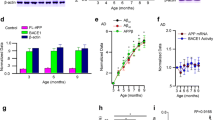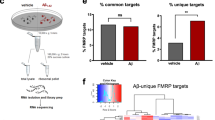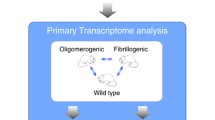Abstract
Amyloid precursor protein (APP) is overexpressed in familiar and sporadic Alzheimer Disease (AD) patients suggesting that, in addition to abnormalities in APP cleavage, enhanced levels of APP full length might contribute to the pathology. Based on data showing that the two RNA binding proteins (RBPs), Fragile-X Mental Retardation Protein (FMRP) and heteronuclear Ribonucleoprotein C (hnRNP C), exert an opposite control on APP translation, we have analyzed whether expression and translation of these two RBPs vary in relation to changes in APP protein and mRNA levels in the AD brain at 1, 3, and 6 months of age. Here, we show that, as expected, human APP is overexpressed in hippocampal total extract from Tg2576 mice at all age points. APP overexpression, however, is not stable over time but reaches its maximal level in 1-month-old mutants in association with the stronger (i) reduction of FMRP and (ii) augmentation of hnRNP C. APP levels then decrease progressively as a function of age in close relationship with the gradual normalization of FMRP and hnRNP C levels. Consistent with the mouse data, expression of FMRP and hnRNP C are, respectively, decreased and increased in hippocampal synaptosomes from sporadic AD patients. Our findings identify two RBP targets that might be manipulated for reducing abnormally elevated levels of APP in the AD brain, with the hypothesis that acting upstream of amyloidogenic processing might contribute to attenuate the amyloid burden.





Similar content being viewed by others
References
Stancu IC, Ris L, Vasconcelos B, Marinangeli C, Goeminne L, Laporte V et al (2014) Tauopathy contributes to synaptic and cognitive deficits in a murine model for Alzheimer’s disease. FASEB J 28(6):2620–2631. doi:10.1096/fj.13-246702
Spires-Jones TL, Hyman BT (2014) The intersection of amyloid beta and tau at synapses in Alzheimer’s disease. Neuron 82(4):756–771. doi:10.1016/j.neuron.2014.05.004, Review
Ding Y, Ko MH, Pehar M, Kotch F, Peters NR, Luo Y et al (2012) Biochemical inhibition of the acetyltransferases ATase1 and ATase2 reduces β-secretase (BACE1) levels and Aβ generation. J Biol Chem 287(11):8424–8433. doi:10.1074/jbc.M111.310136
Sankaranarayanan S, Price EA, Wu G, Crouthamel MC, Shi XP, Tugusheva K et al (2008) In vivo beta-secretase 1 inhibition leads to brain Abeta lowering and increased alpha-secretase processing of amyloid precursor protein without effect on neuregulin-1. J Pharmacol Exp Ther 324(3):957–969
Sadleir KR, Eimer WA, Cole SL (2015) Vassar R Aβ reduction in BACE1 heterozygous null 5XFAD mice is associated with transgenic APP level. Mol Neurodegener 10(1):1. doi:10.1186/1750-1326-10-1
Schafer MJ, Alldred MJ, Lee SH, Calhoun ME, Petkova E, Mathews PM et al (2014) Reduction of β-amyloid and γ-secretase by calorie restriction in female Tg2576 mice. Neurobiol Aging. doi:10.1016/j.neurobiolaging.2014.10.043
Strömberg K, Eketjäll S, Georgievska B, Tunblad K, Eliason K, Olsson F et al (2015) Combining an amyloid-beta (Aβ) cleaving enzyme inhibitor with a γ-secretase modulator results in an additive reduction of Aβ production. FEBS J 282(1):65–73. doi:10.1111/febs.13103
Fernandez MA, Klutkowski JA, Freret T, Wolfe MS (2014) Alzheimer presenilin-1 mutations dramatically reduce trimming of long amyloid β-peptides (Aβ) by γ-secretase to increase 42-to-40-residue Aβ. J Biol Chem 289(45):31043–31052. doi:10.1074/jbc.M114.581165
Jacobsen H, Ozmen L, Caruso A, Narquizian R, Hilpert H, Jacobsen B et al (2014) Combined treatment with a BACE inhibitor and anti-Aβ antibody gantenerumab enhances amyloid reduction in APP London mice. J Neurosci 34(35):11621–11630. doi:10.1523/JNEUROSCI.1405-14.2014
Subaiea GM, Ahmed AH, Adwan LI, Zawia NH (2015) Reduction of amyloid-β deposition and attenuation of memory deficits by tolfenamic acid. J Alzheimers Dis 43(2):425–433. doi:10.3233/JAD-132726
Vignini A, Morganti S, Salvolini E, Sartini D, Luzzi S, Fiorini R et al (2013) Amyloid precursor protein expression is enhanced in human platelets from subjects with Alzheimer’s disease and Frontotemporal lobar degeneration: a real-time PCR study. Exp Gerontol. doi:10.1016/j.exger.2013.10.008
Johnston JA, Cowburn RF, Norgren S, Wiehager B, Venizelos N, Winblad B et al (1994) Increased beta-amyloid release and levels of amyloid precursor protein (APP) in fibroblast cell lines from family members with the Swedish Alzheimer’s disease APP670/671 mutation. FEBS Lett 354(3):274–278
Matsui T, Ingelsson M, Fukumoto H, Ramasamy K, Kowa H, Frosch MP et al (2007) Expression of APP pathway mRNAs and proteins in Alzheimer’s disease. Brain Res 1161:116–123
Lee EK, Kim HH, Kuwano Y, Abdelmohsen K, Srikantan S, Subaran SS et al (2010) hnRNP C promotes APP translation by competing with FMRP for APP mRNA recruitment to P bodies. Nat Struct Mol Biol 17(6):732–739. doi:10.1038/nsmb.1815
Westmark CJ, Malter JS (2012) The regulation of AβPP expression by RNA-binding proteins. Ageing Res Rev 11(4):450–459. doi:10.1016/j.arr.2012.03.005
Ruberti F, Barbato C, Cogoni C (2010) Post-transcriptional regulation of amyloid precursor protein by microRNAs and RNA binding proteins. Commun Integr Biol 3(6):499–503. doi:10.4161/cib.3.6.13172
Laggerbauer B, Ostareck D, Keidel EM, Ostareck-Lederer A, Fischer U (2001) Evidence that fragile X mental retardation protein is a negative regulator of translation. Hum Mol Genet 10(4):329–338
Westmark CJ, Malter JS (2007) FMRP mediates mGluR5-dependent translation of amyloid precursor protein. PLoS Biol 5(3):e52
Rajagopalan LE, Westmark CJ, Jarzembowski JA, Malter JS (1998) hnRNP C increases amyloid precursor protein (APP) production by stabilizing APP mRNA. Nucleic Acids Res 26(14):3418–3423
Zaidi SH, Malter JS (1995) Nucleolin and heterogeneous nuclear ribonucleoprotein C proteins specifically interact with the 3′-untranslated region of amyloid protein precursor mRNA. J Biol Chem 270(29):17292–17298
Renoux AJ, Carducci NM, Ahmady AA, Todd PK (2014) Fragile X mental retardation protein expression in Alzheimer’s disease. Front Genet 5:360. doi:10.3389/fgene.2014.00360. eCollection 2014
Hamilton A, Esseltine JL, DeVries RA, Cregan SP, Ferguson SS (2014) Metabotropic glutamate receptor 5 knockout reduces cognitive impairment and pathogenesis in a mouse model of Alzheimer’s disease. Mol Brain 7:40. doi:10.1186/1756-6606-7-40
Westmark CJ, Westmark PR, O’Riordan KJ, Ray BC, Hervey CM, Salamat MS et al (2011) Reversal of fragile X phenotypes by manipulation of AβPP/Aβ levels in Fmr1KO mice. PLoS One 6(10):e26549. doi:10.1371/journal.pone.0026549
Rumble B, Retallack R, Hilbich C, Simms G, Multhaup G, Martins R et al (1989) Amyloid A4 protein and its precursor in Down’s syndrome and Alzheimer’s disease. N Engl J Med 320(22):1446–1452
Rovelet-Lecrux A, Hannequin D, Raux G, Le Meur N, Laquerrière A, Vital A et al (2006) APP locus duplication causes autosomal dominant early-onset Alzheimer disease with cerebral amyloid angiopathy. Nat Genet 38(1):24–26
Brouwers N, Sleegers K, Engelborghs S, Bogaerts V, Serneels S, Kamali K et al (2006) Genetic risk and transcriptional variability of amyloid precursor protein in Alzheimer’s disease. Brain 129(Pt 11):2984–2991
Long JM, Ray B, Lahiri DK (2012) MicroRNA-153 physiologically inhibits expression of amyloid-β precursor protein in cultured human fetal brain cells and is dysregulated in a subset of Alzheimer disease patients. J Biol Chem 287(37):31298–31310. doi:10.1074/jbc.M112.366336
Born HA, Kim JY, Savjani RR, Das P, Dabaghian YA, Guo Q et al (2014) Genetic suppression of transgenic APP rescues hypersynchronous network activity in a mouse model of Alzeimer’s disease. J Neurosci 34(11):3826–3840. doi:10.1523/JNEUROSCI.5171-13.2014
Westmark CJ, Westmark PR, Beard AM, Hildebrandt SM, Malter JS (2008) Seizure susceptibility and mortality in mice that over-express amyloid precursorprotein. Int J Clin Exp Pathol 1(2):157–168
Amatniek JC, Hauser WA, Del Castillo-Castaneda C, Jacobs DM, Marder K, Bell K et al (2006) Incidence and predictors of seizures in patients with Alzheimer’s disease. Epilepsia 47(5):867–872
Asuni AA, Guridi M, Pankiewicz JE, Sanchez S, Sadowski MJ (2014) Modulation of amyloid precursor protein expression reduces β-amyloid deposition in a mouse model. Ann Neurol 75(5):684–699. doi:10.1002/ana.24149
Funding
This research was funded by MIUR/CNR on the project for aging with the project: “Disease mechanism of working memory load capacity in aging and Alzheimer disease” to M.A.T (coordinator of the project) and A.B... The funder had no role in the study design, data collection and analysis, decision to publish, or preparation of the manuscript.
Conflict of Interest
The authors declare that they have no conflicts of interest.
Author information
Authors and Affiliations
Corresponding author
Electronic Supplementary Material
Below is the link to the electronic supplementary material.
Supplementary Fig. 1
Analysis of PS1 levels expression in the hippocampus of Tg2576 mice during development and adulthood. Upper panel: histograms showing the levels of PS1 in Tg2576 and WT hippocampi. Lower panel: representative immunoblots used for quantification. Data were normalized with β-actin and expressed as mean ± s.e.m (TIFF 3804 kb)
Rights and permissions
About this article
Cite this article
Borreca, A., Gironi, K., Amadoro, G. et al. Opposite Dysregulation of Fragile-X Mental Retardation Protein and Heteronuclear Ribonucleoprotein C Protein Associates with Enhanced APP Translation in Alzheimer Disease. Mol Neurobiol 53, 3227–3234 (2016). https://doi.org/10.1007/s12035-015-9229-8
Received:
Accepted:
Published:
Issue Date:
DOI: https://doi.org/10.1007/s12035-015-9229-8




